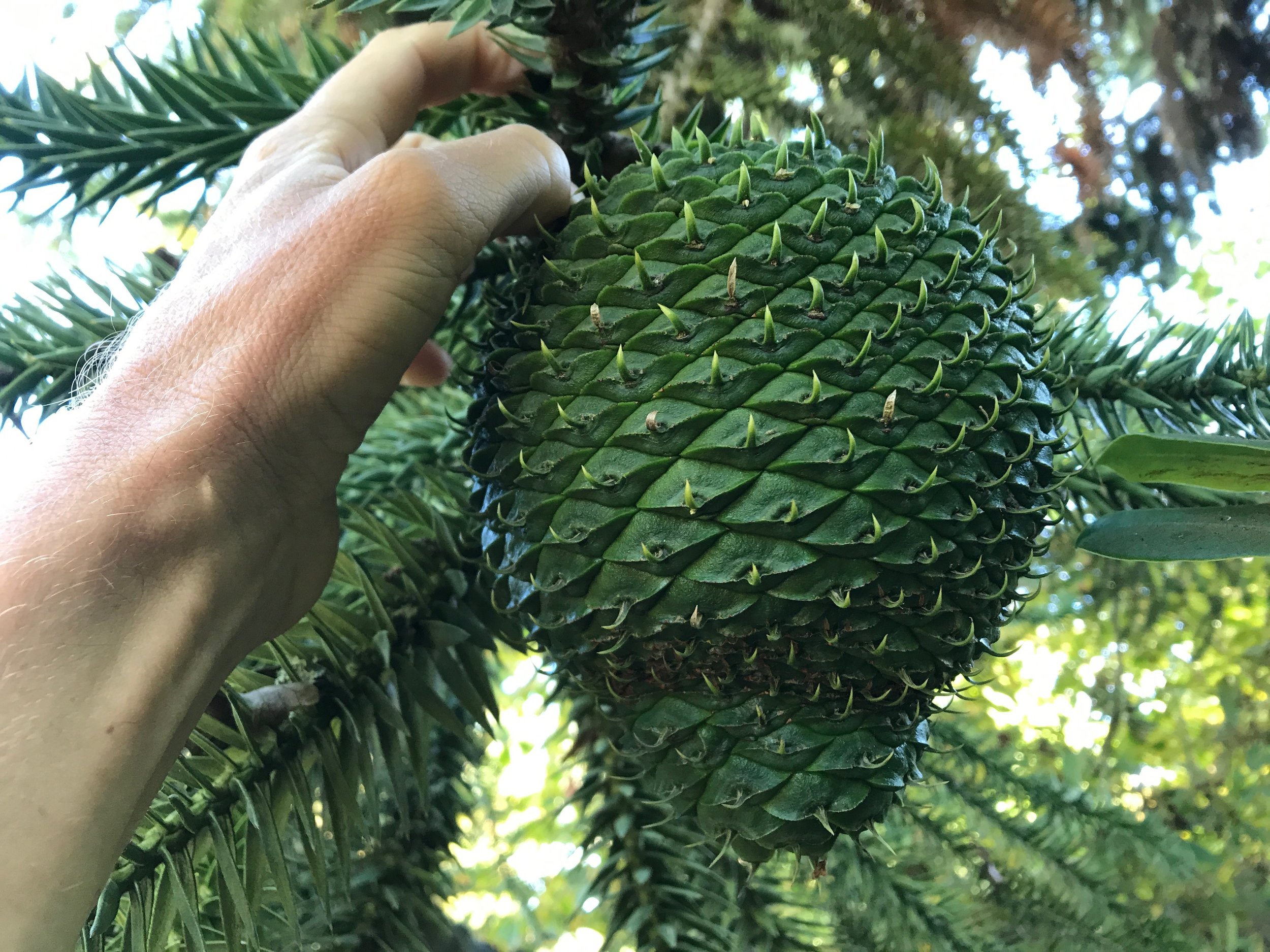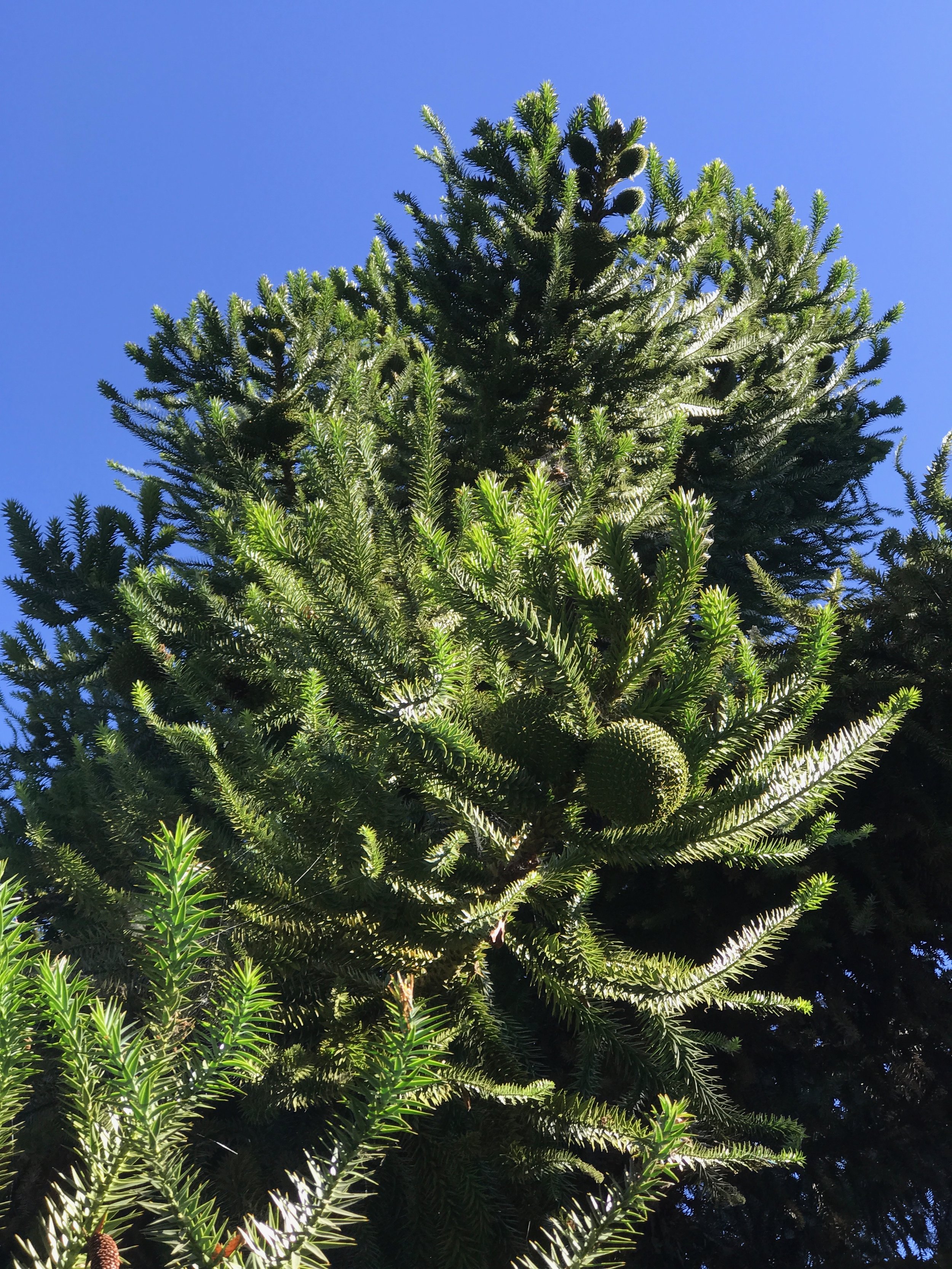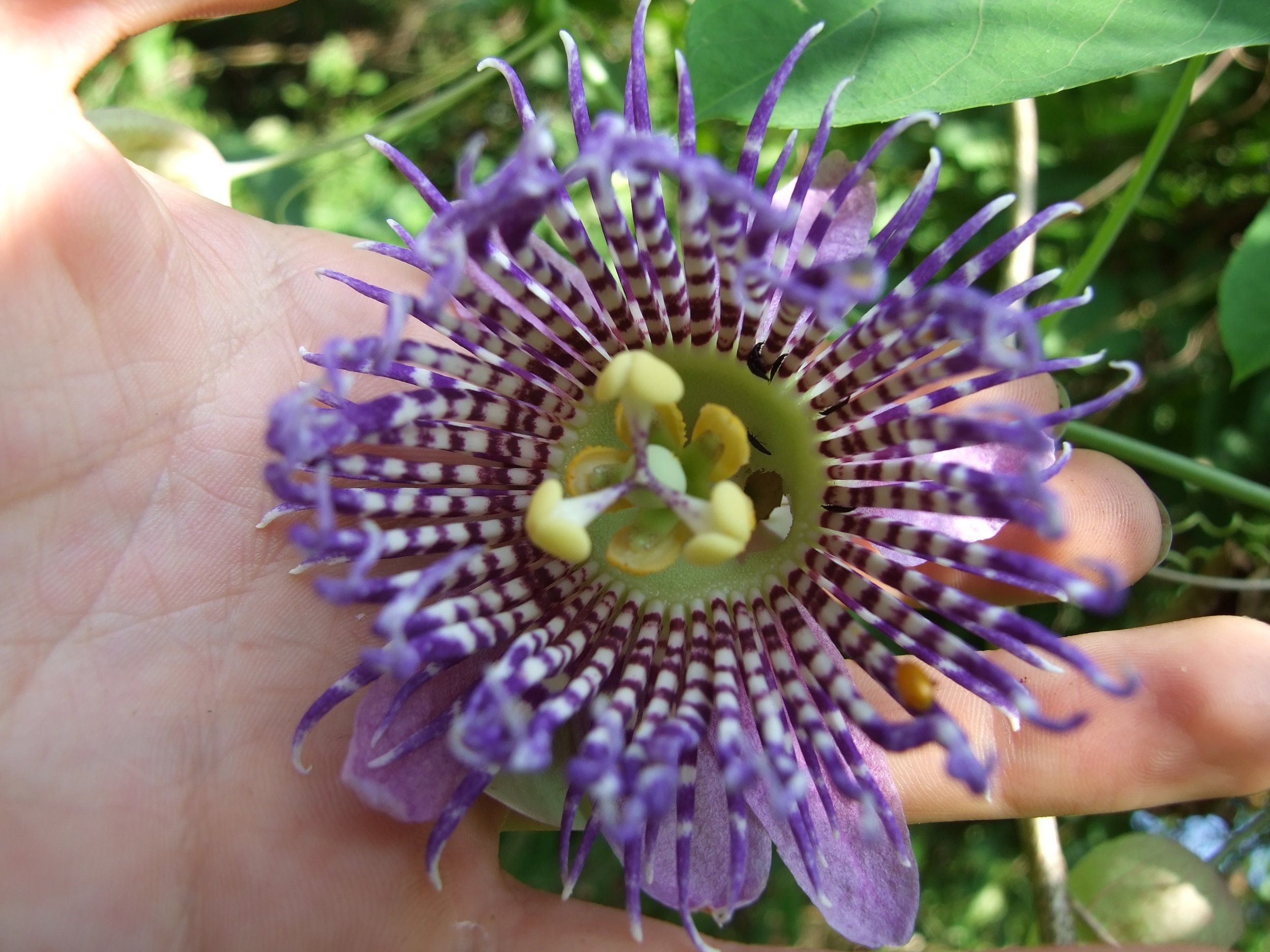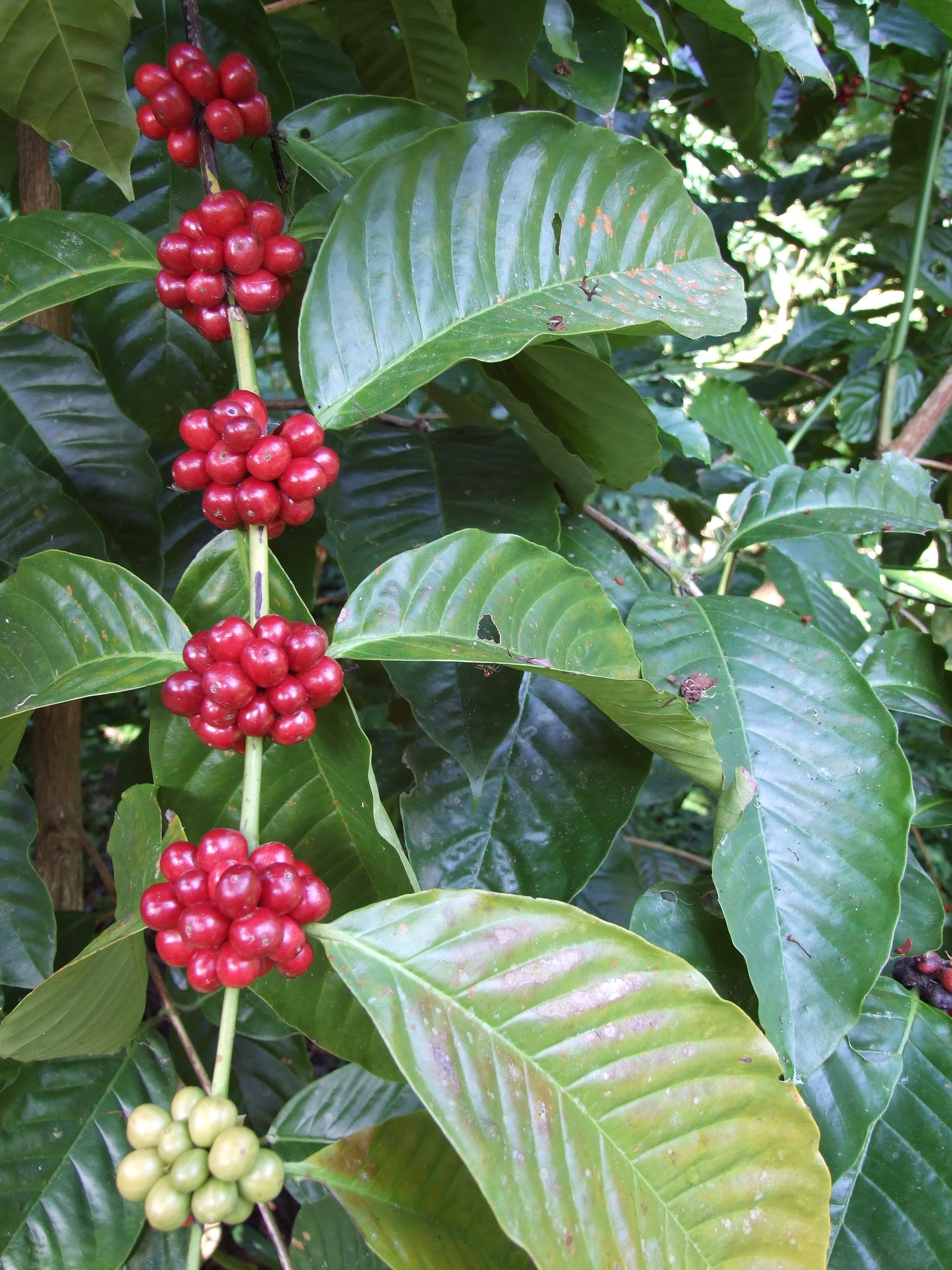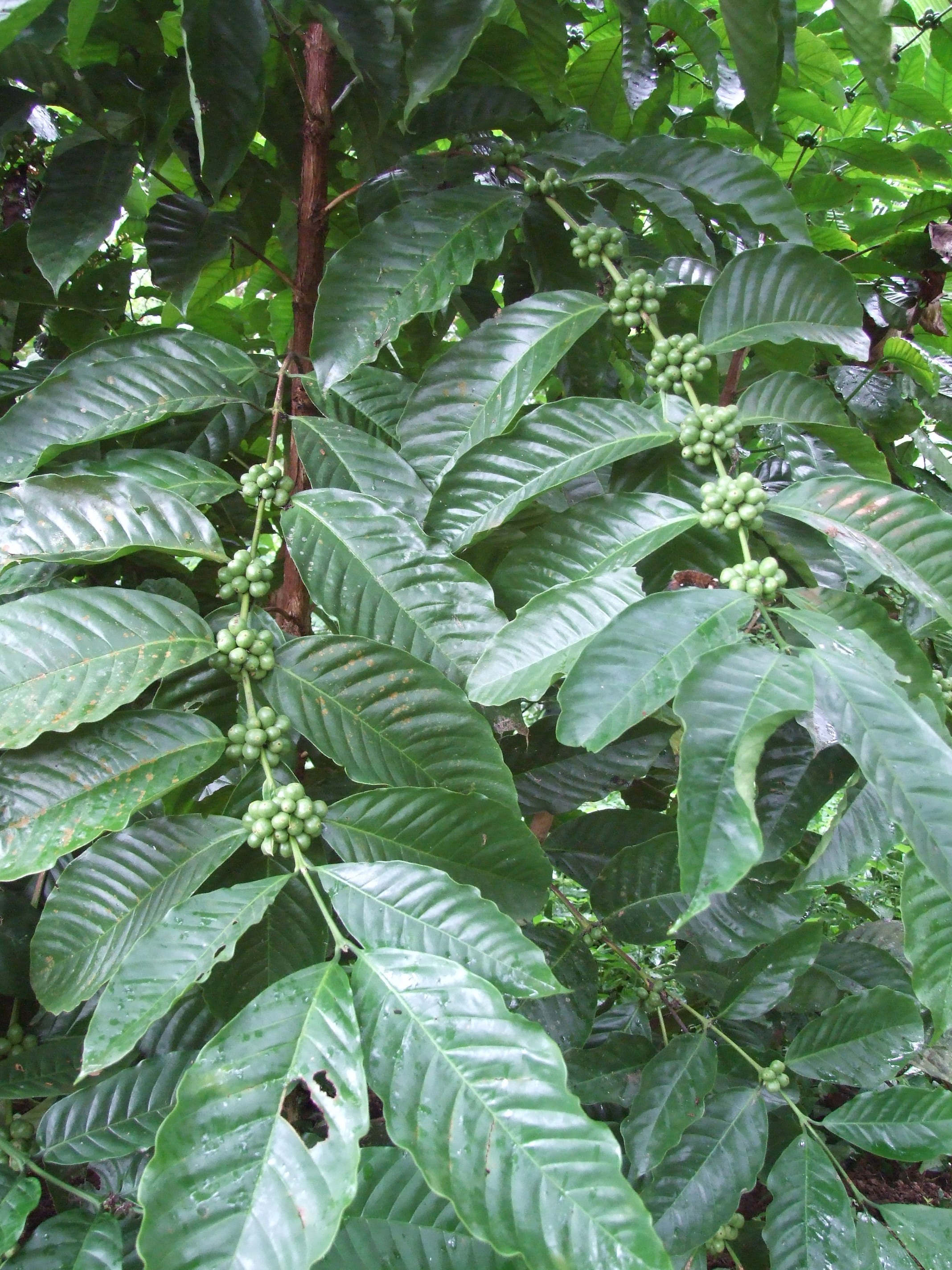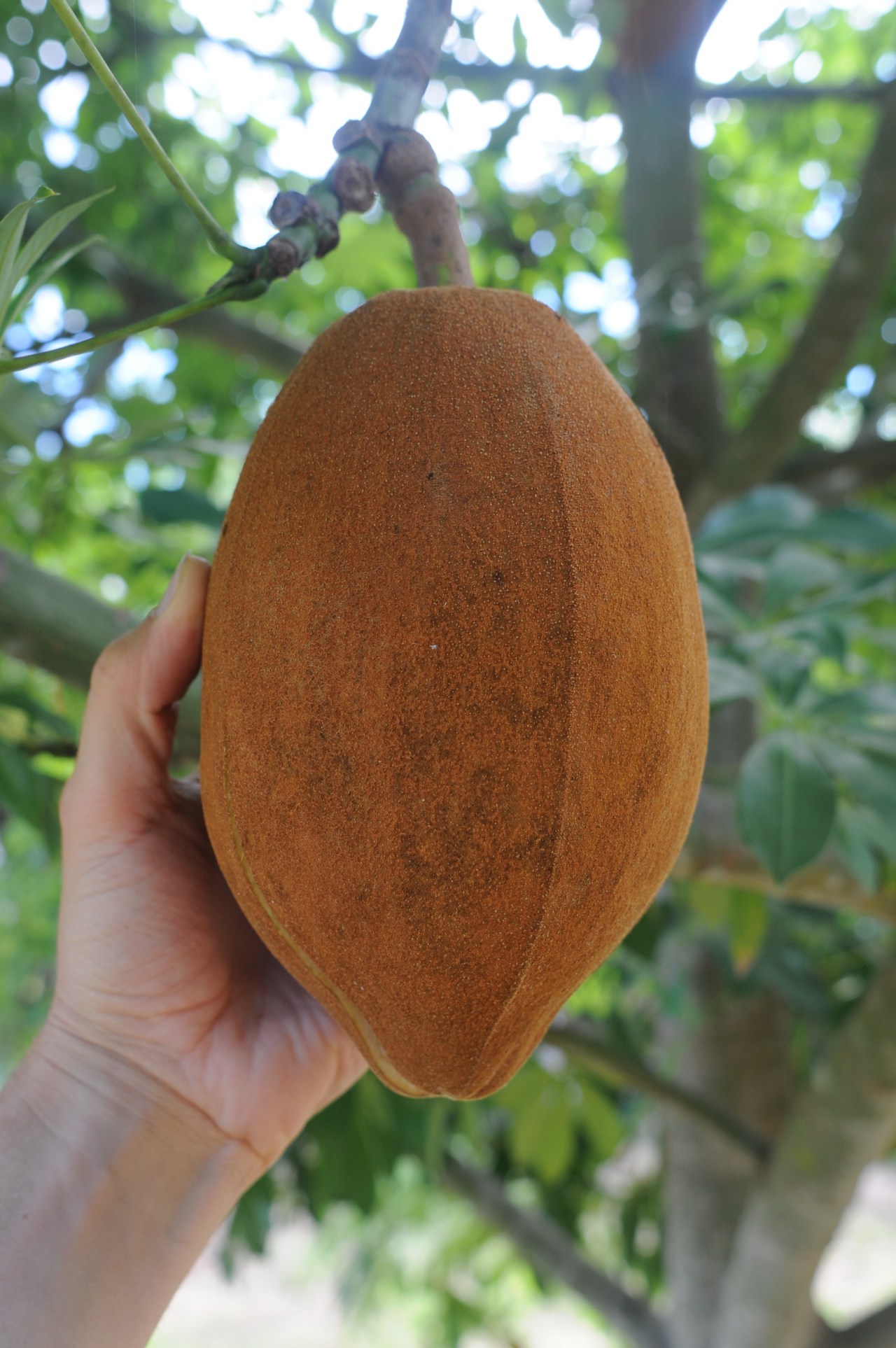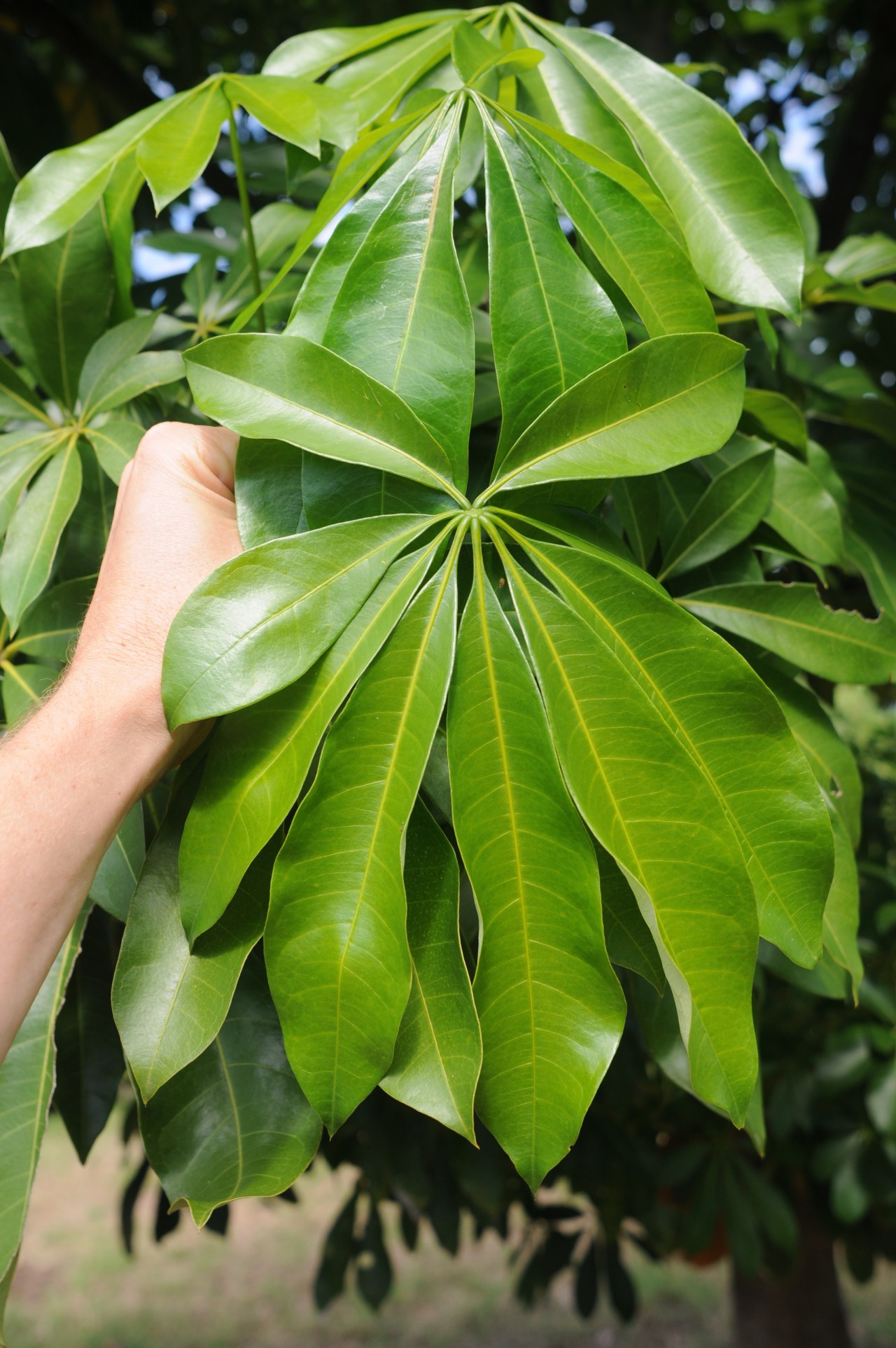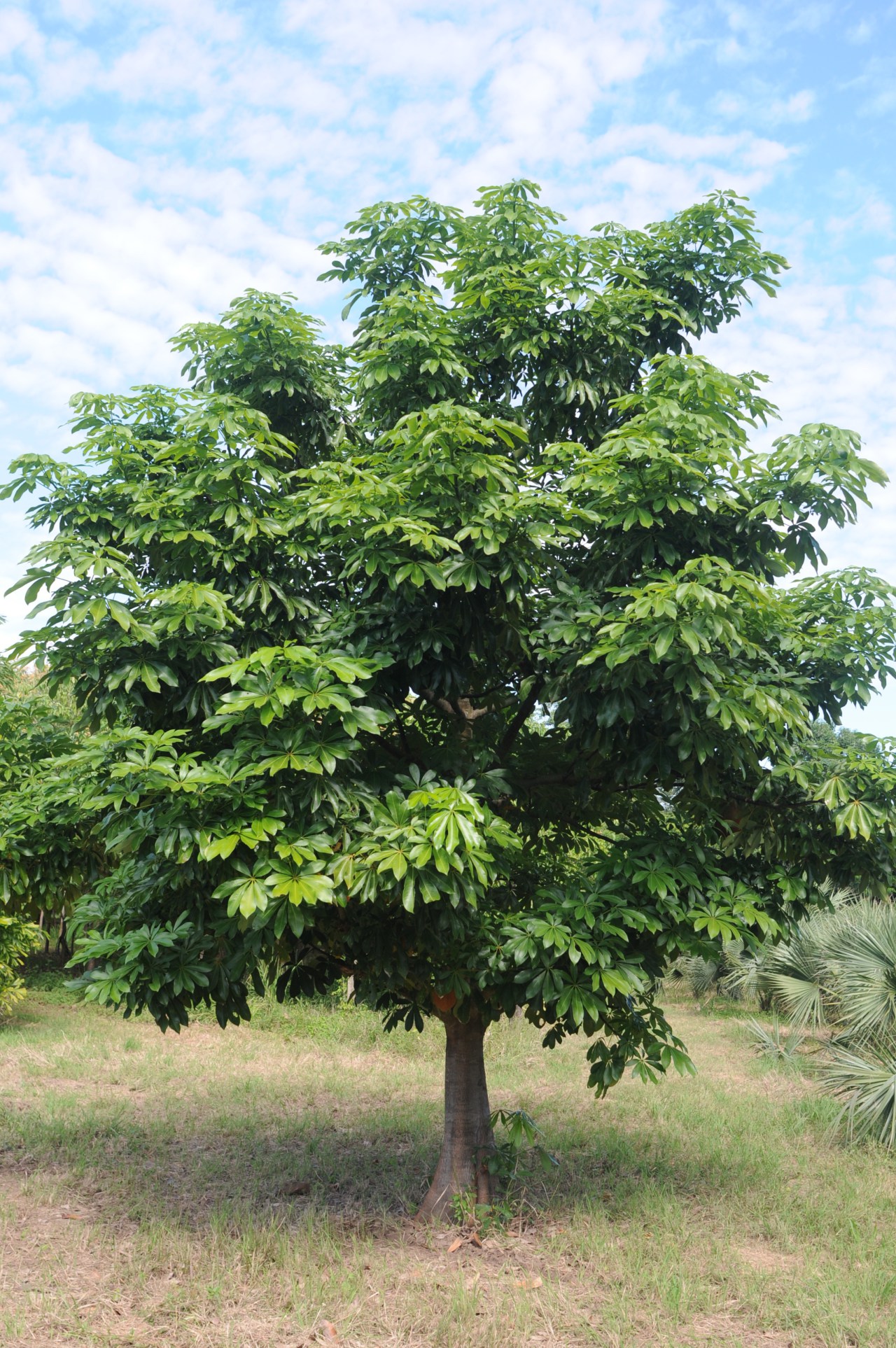Randia formosa - blackberry jam fruit
Randia formosa is a memeber of the Rubiaceae family, native to Brazil. Is a small tree related to gardenia and coffee and Psychotria spp, among others. The tree / shrub has a has fragrant, white flowers similar in aroma to the gardenia. The tree doesn't get much taller than eight feet. The fruit is a yellow capsule with an almost brittle shell, similar in shape, although smaller in size, to the pomegranate (Punica granatum). Upon breaking open the capsule, one will find dark, jam-like pulp embedded with numerous seeds. The pulp has a taste similar to that of blackberry jam, or some other jam, thus the name.
Passiflora seemanii
Here are some photos of a Passiflora variety I found on an island off the Northern Caribbean coast of Panama
Passiflora seemanii flower.
Passiflora seemanii close up.
Coffea canephora - Canephora Coffee
BACKGROUND, ORIGIN AND DISTRIBUTION
Coffea canephora, otherwise known as Robusta coffee, is native to Central and Western Sub-Saharan Africa. I took this photo in the Northern Caribbean Islands in Panama where we were planting it as a shaded understory intercrop to larger hardwoods and crown bearing fruit trees. .
Native to the upland forests of Ethiopia, Coffea robusta was only recognized as a coffee species in 1897, almost 100 years after Coffea arabica.
Most Robusta coffee today is grown in Vietnam, where it was introduced by French colonists in the late 19th century.
USES AND ETHNOBOTANY
40% of the coffee in the world is Robusta coffee. Robusta has a greater crop yield and more caffeine then Arabica coffee. This species is also less succeptible to pests and diseases then Arabica, therefore relying on less herbicide and pesticides in commercial cultivations.
That Robusta coffee plants are less susceptible to pest and diseases begs the question of weather or not the plant may have more mycorrhizal associations with beneficial fungi, thereby improving overall resilience and health.
PROPAGATION AND CULTIVATION
Coffee can be easily grown from seed. Seeds benefit from a light fermentation over a few days in their skin prior to germination. The pre-fermentation basically mimics the natural process that fruit goes through after it matures and drops to the ground in the tropics. After the light fermentation seeds can then be rinsed in clean water, removing any residual pulp.
Coffee seedlings can often be found germinating around the base of a fruit bearing plant. Reportedly the plant has naturalized in a number of countries throughout the world including Borneo, French Polynesia, Costa Rica, Nicaragua, Jamaica, and the Lesser Antilles.
Pachira aquatica - Guinea Chestnut, Apompo
Pachira aquatica is a medium size tree native to tropical wetlands of Central and South America. Its native habitat tends to be seasonally flooded lowlands or swamps, however it is adaptable to a wide range of tropical environments. The large, oblong fruit is full of large seeds which taste reminiscent of peanuts, and can be eaten raw, cooked, or ground into flour to make bread. The leaves and flowers are also edible.
Interestingly Pachira aquatica and close relative Pachira glabra are both used and sold with braided trunks as the "money tree", an indoor plant that is supposed to bring monetary wealth. Personally I prefer to plant them in the ground outside.
Nicotiana rustica - mapacho, махорка, thuốc lào, tobacco
BACKGROUND AND ORIGIN
This is an enthogenic species of Nicotiana (tobacco) native to South America containing up to nine times more nicotine then commercial Nicotiana tabaccum. N. rustica leaves also contain high levels of β-carbolines including harmala alkaloids.
USES AND ETHNOBOTANY
In South American ethnobotanical preparations, Mapacho (Nicotiana rustica) leaves are soaked or infused in water, and the water is then insufflated into the stomach in a preparation known as singado or singa; the leaves can also smoked in cigars , used as an enema, made into a lickable product known as ambil, and made into a snuff with the bark of a species of Theobroma, creating nu-nu. In the southeast part of Turkey, people use this herb and ashes of some tree bodies to make a moist snuff called maraş otu. They use this by putting the mixture under their lips like Swedish snus or Afghan naswar. It is also a common admixture of Ayahuasca in some parts of the Amazon. The leaves of N. rustica can be used to make a powerful organic insecticide and are used in the production of pesticides due to the high concentration of nicotine. I keep the plant scattered here and there throughout the garden as I feel its presence deters some detrimental garden pests.
One word of advice would be to not self - administer this plant without full knowledge of its potency and potential effects.
PROPAGATION AND CULTIVATION
Nicotiana rustica can be easily propagated from seed. As the seeds are very small, the most straight forward method I have used is to lightly sprinkle seeds across a moist propagation medium. If seeds are kept in a humid environment they do not need to be covered in soil to germinate. Wait until seedlings have developed their seconds set of leaves to divide them and transplant into individual containers.
Banisteriopsis caapi - Yage, Ayahuasca
Following are portions of a research paper I wrote on the uses of Banisteriopsis caapi and Ayahuasca in 2005.
-
Hallucinogens, also called psychedelics, or entheogens, have been used since prehistoric times in the practice of healing and divination (Stuart, R 2004). Ayahuasca is a powerful plant hallucinogen employed by indigenous societies of the western Amazon basin. The concoction is considered to be the most potent and widely used of all shamanic hallucinogens. Over the last several years ayahuasca has begun to attract increasing interest from a wide variety of disciplines within the modern scientific community.
In its traditional context, Ayahuasca is perceived as a magical intoxicant of divine origin, which facilitates release of the soul from its corporeal confinement, allowing it to wander free and return to the body at will, carrying with it information of vital import (Shultes and Hofmann 1992).
Utilized and administered by local shaman or curanderos (Ayahuasceros and Vegtalistas) in the diagnosis and curing of patients (among other applications) ayahuasca enables the experienced practitioner to see the inner constituents of his patients body and soul. The brew acts as an access point for the shaman into the divine world of creation where intelligent beings guide him, passing knowledge and information. When curing a sick patient the shaman performs an ayahuasca ceremony, or a series of them, to discern, through hallucinatory diagnosis, which plant will act as a suitable treatment (Shannon, Metzner 1999).
The various additional uses of ayahuasca by non-urban native American Amazonian cultures include: to obtain divine guidance and to communicate with the spirits that animate plants; to achieve trance states; to train prospective shaman; to induce dreams so as to divine the future; for prophesy; as a telepathic agent; to cure illness through psychic or physical means; as a preventive agent against the malice of other people; as a diagnostic tool where the visions are used to prescribe remedies for illness; to identify an evil doer or agent responsible for illness; and to achieve ecstasy in the service of health and political acumen (Siskind 1973).
One shaman from the el Valle de Sibundoy (Colombia) states, “Yage (ayahuasca) is a force that has power, will and knowledge; with it we can reach the stars, enter the spirit of other people, know their desire to do good or bad; we can foresee the future of ours and others’ lives, see illnesses and cure them, and with it we can travel to heaven or hell.” Richard Evan Schultes, the father of western ethnobotany, offers similar emphasis to the omniscience of the sacred brew: “Ayahuasca truly enters into every aspect of living. It reaches into prenatal life, influences life after death, operates during earthly existence, plays roles not only in health and sickness, but in relations between individuals, villages and tribes, in peace and war, at home and in travel, in hunting and in agriculture. In fact, one can hardly name any aspect of living or dying, wakefulness or sleep, where caapi hallucinogens do not play a vital, nay, overwhelming, role” (Schultes).
Ayahuasca is utilized in a wide variety of medicinal application. As I will discuss further, neurologist Kurt Beringr explored the effects of banisterine, also known as telepathine (in reference to the legendary properties of the jungle vine) in the treatment of Parkinson’s Disease. Administering the drug to fifteen patients with postencephalitic Parkinsonism, Beringer reported the dramatic improvement of the classic symptoms of rigidity and akinesia (Beringer 1928, Metzner). Dennis McKenna concludes that, “a considerable body of anecdotal evidence, coupled with a long history of ethnomedical use, indicates that ayahuasca may be useful for the treatment of abuse disorders, such as alcoholism and substance abuse, as well as for physical maladies such as cancer” (McKenna).
Although the hallucinatory knowledge of indigenous people has been empirically confirmed by science and used by the pharmaceutical industry in the synthetic production of medicine, its origins cannot be discussed scientifically because to do so would be to contradict the foundations of western knowledge (Narby ). Science does not have the capacity to further the study of Ayahuasa because it has built itself upon a founding declaration, which dismisses and denounces the existence of realities or intelligence beyond that which we can perceive here, in our physical, material reality. Science has exhausted the external examination of the people and culture surrounding the central phenomenon but can tell us nothing about the super-conscious, trans-dimensional, spiritual experiences induced by the sacred brew. What is the most effective way to further our understanding of ayahuasca’s function within western Amazonian societies? A logical place to start would be within ayahuasca’s culture of origin, through their lense of perception. Non-scientific ideologies, practices, theories, traditions can reveal some of the major shortcomings of science, but only they are given a fair chance to compete.
The modern Western world is not yet in a position from which it can begin to develop theories concerning what Ayahuasca “does”, or how and in what ways it “affects the brain”. To determine ayahuasca’s potential value, not merely as a medicine, but as a source of vital knowledge concerning the nature of reality, it is crucial to move beyond the boundaries of conventional models of study in order to incorporate the lessons learned past cultures into our way of thinking and understanding (Dobkin de Rios & Grob 2005). Not until a direct and extensive connection is established between an outside researcher and the ayahuasca experience itself will any understanding develop regarding the reality of ayahuasca. Not until outside researchers establishes longitudinal collaborative apprenticeships with experienced ayahuasceros and vegetalistas will they begin to understand the hallucinatory-based epistemology as interpreted within its cultural, religious and ideological context of origin. Experienced ayahuasceros must interact in these study not as subjects, or "problems", to be studied, but as a source of highly evolved perspective through which the more central phenomenon can be better understood. Until methods are conceived of through which this subjective and cross-cultural experiential conception of the ayahuasca phenomenon can be extended and expanded upon, western understanding will not evolve any further, remaining on the surface - self-righteous, ignorant and confused.
The key is devising a method of inquiry that will prove logistically sound, morally and ethically balanced and complete in design; a method in which modern science is not in the drivers seat, asking questions, choosing areas of exploration, fabricating conclusions.
-
Ayahuasca is regarded by western anthropologists as the most potent and widely used of all shamanic hallucinogens and is rapidly developing a name and reputation for itself amongst inquisitive members of the western world. My concern is that this reputation is growing increasingly phenomenological and bastardized due to lack of clarity and information.
Due to its widespread usage across the western Amazon, including the Peruvian, Colombian and Ecuadorian parts of the basin, it is likely that ayahuasca has hundreds of names. A few more common names include: caapi, natema, mihi, kahi, pinde, dapa and hosca. The word Ayahuasca comes from Incan Quechua. “Aya” means “soul”, “dead people” or “spirits.” “Huasca” means vine. Thus, Ayahuasca can be translated as vine of the dead, vine of the soul, or vine of the spirits. Today, the use of ayahuasca in its traditional context is diminishing due to the systematic slaughter of the Amazon forest and those societies dwelling within it. Notwithstanding, there are an estimated seventy-two ayahuasca using cultures in existence today (Narby, Metzner). As traditional usage declines and indigenous people are forced to move out of their forest environs, mestizo ayahuasceros, spurred on by an emerging ayahuasca tourism, are proliferating across Amazonian urban landscapes.
The origins of Ayahuasca remain vague through the eyes of the scientific world. The earliest artifacts thought to represent symbology pertaining to ayahuasca date back 4-5 thousand years, however legend has it that ayahuasca has been used since the beginnings of mankind. To the societies in which Ayahuasca plays a central role, the origins and history of Ayahuasca use are not at all obscure. Although many separate, individual Amazonian societies possess their own explanation of its beginnings and its role in the lives of their ancestors, it is significant to note that each oral tradition includes numerous corresponding details and follows relatively the same course of events. In the Vapues region of the Colombian Amazon the Tukano believe that the first people came from the sky in a serpent canoe. Father Sun had promised them a magical drink that would connect them with the radiant powers of the heavens. As the legend tells it: while the men were in the “House of the Waters,” attempting to make this drink, the first woman went into the forest to give birth. She came back with a boy radiating golden light, whose body she rubbed with leaves. This luminous boy-child was the vine, and each of the men cut off a piece of this living being, which became his piece of the vine lineage. Similarly, a Densana version of the tale also speaks of a serpent canoe, which, in this version, was sent by the sun but came from the Milky Way, bringing a man, a woman and three plants for the people – cassava, coca and caapi. The examples of ayahuasca mythology are numerous and very similar and to explore each of them would be beyond the scope of this paper. – Nearly all stories relaying the origins of Ayahuasca communicate that the vine given to the people as a gift from a some superdivine cosmic power and that its purpose was/is to provided humans with the rules of how to live and how to speak, art, religion and culture (Reichel-Dolmatoff 1972, Metzner, Grob). Amongst curanderos (curers) there exist a few important delineations. Curandero can apply to all who cure, including Vegetalistas, Shaman and Ayahuasceros. The term Shaman, although widely used as a local term interchangeable with curandero, finds its roots in the Siberian Tungus language. Narby (2001) defines “Shamanism" as a variety of “defocalization” techniques: controlled dreams, prolonged fasting, isolation in wilderness, ingestion of hallucinogenic plants, hypnosis based on a repetitive drumbeat, near-death experience, or a combination of the above.
There is an important distinction to be made between “Vegtalista” and “Ayahuascero”. Vegetalistia almost always pertains to the indigenous shamans of the Upper Amazon working in a purely traditional context who, working with a variety of plants, derive their healing skills and powers from plant teachers. Their medical knowledge is derived from the plants themselves, the Vegetalista mediates the transmission of information. You can only become a good Vegetalista by keeping a strict diet for years, then you become one that knows the science of the muraya, of the sumi, and of the banco, which are the three highest degrees in the traditional Vegetalista medicine of the Amazon.
“Ayahuascero” is a term normally applying to a curandero who works mainly through the ayahuasca medium. Although a Vegetalista can be considered an Ayahuascero, and Ayahuascero isn’t always a Vegetalista (Metzner 1999, Shanon 2001). In the contemporary societal context Ayahuasca has been described as “an experience that binds the tribe in their philosophy and mutual interdependence to survive and thrive in an eternally challenging environment” (Stuart, R 2004).
In addition to the widespread use of ayahuasca in indigenous tribes of the western Amazon, it is also used in the context of organized religion, or syncretic ayahuasca churches, whose members consume the brew as sacrament. Santo Daime, Uniao do Vegetal, and Barquinha are the three largest churches today. Apart from indigenous populations it is estimated that there exist some 15,000 monthly consumers of ayahuasca working outside the traditional context (Shanon, Grunwell). The intentional focus in these groups is not so much on healing and visioning, but on group worship and celebration with singing and prayer. Instead of a shaman or healer, there are priests and officiants (Metzner 1999). As Grob and McKenna report in their research with the long-term ayahuasca users of the Uniao do Vegetal (UDV), there is a marked reduction in the incidence of alcoholism and drug addiction (Metzner 1999).
The ayahuasca brew, or tea, consists of two plant species – a large jungle liana, also called ayahuasca, Banesteriopsis caapi, and a leaf most commonly known as chacruna, or Psychotria viridis. In addition to being the common name for one of the essential ingredients, “Ayahuasca” also refers to the combination of these two ingredients.
Ayahuasca and its analogues exists apart from all other ethnobotanical hallucinogens in that it contains, and functions by way of, the only known psychotropic molecule produced naturally in the human body by the human brain: DMT or dimethyltriptamine. Tests searching for DMT in other living beings have found it virtually everywhere they’ve looked, throughout the plant and animal kingdoms (Strassman). Recent studies have been conducted testing neurological and psychological effects of ayahuasca on the human brain. From these findings new words, such as entheogen and nootropic, have been invented in order to describe its classifications and effects. “Nootropic” is a term used to describe a ‘cognition enhancer.’ “Entheogen” specifies a psychotropic molecule that ‘connects to the sacred from within’. In the case of ayahuasca that nootropic entheogen is DMT. It is believed that di-methyl-triptamine is produced in the penal gland, a tiny organ situated in the middle of the human brain (Strassman 2001, Metzner 1999). Strassman notes: “The pineal gland is unique in its solitary status within the brain. All other brain sites are paired, meaning that they have left and right counterparts; for example, there are left and right frontal lobes and left and right temporal lobes. As the only unpaired organ deep within the brain, the pineal gland remained an anatomical curiosity for nearly two thousand years. No one in the West had any idea what its function was.” It is currently understood that brain releases hallucinogenic amounts of DMT only three times in the course of a human life. The first occurs 49 days after conception, at the same time the first noticeable signs of gender become apparent the fetus is considered to become a sentient being. Then DMT is released again during birth, and at death.
When orally ingested (as opposed to smoked or injected) DMT is instantly inactivated, destroyed by a gastral enzyme called monoamine oxidase. Thus the role of harmine and harmaline alkaloids, present in Banesteriopsis caapi, become significant. Harmine and harmaline are the two main alkaloids present in Banesteriopsis caapi and, possessing specific chemical properties, act as a monoamine oxidase inhibitors, which prevent the monoamine oxidase, present in our stomachs, from blocking orally ingested DMT, thus allowing it to cross the blood brain barrier as a potent hallucinogen (Metzner 1999, Shanon 2001). The late 20th century father of ethnobotany, Richard Evan Shultes, had this to remark about such a phenomenon: “One wonders how peoples in primitive societies, with no knowledge of chemistry or physiology, ever hit upon a solution to the activation an alkaloid by a monomine oxidase inhibitor. Pure experimentation? Perhaps not. The examples are too numerous” (Hancock 2005).
Considering that the Amazon rainforest is the largest wilderness area on earth, estimated to contain over 80,000 known plant species and most likely tens of thousands more either undiscovered or destroyed, it seems unlikely that a process of trial and error, however long, would lead forest dwelling peoples to discover the specific combination of two plants that produces such an incredibly rare effect.
What pervades Ayahuasca induced experiences are visions and transformation of/into non-human elements of the natural world and visions of human cultures and their expressions – cities, palaces and temples, artifacts and works of art, royalty and religious figures, rites and rituals (Shanon 2001). As Shanon writes from his research: “By and large, the ideas of a non-personal nature reported by my informants pertain to these main topical clusters: ontology and the structure and meaning of reality, nature and the phenomenon of knowledge, consciousness and the mind, ides pertaining to human history and its meaning, the divine and the relationship between god and both humankind and the world, ethical values and proper human conduct, and, last but not least, Ayahuasca and the very experience it induces” (Shanon 2001).
Western science believes that hallucinations cannot be the source of “real” knowledge. Furthermore it is relatively clear that western science regards any knowledge derived outside of its narrow constructs to be illegitimate. Hallucinations are deemed to be mere reactions in our brains caused by psychotropic molecules which result in illusory visions. Modern human beings are considered to be the only “intelligent” life. The human species are the only living species (plant or animal) able to communicate in complex ways through abstract symbols, pictures and text. Plants cannot relay information to one another in the form of mental images. In the case of plant hallucinogens, western science considers the brain to be the source of the images produced, which are triggered by hallucinogenic molecules contained within the psychoactive plants. The problem then is this: Amazonian indigenous peoples claim to have gained their vast pharmacopeoa of medicinal plant knowledge through the teachings of ayahuasca (hallucinatory) and various other psychotropic plants concoctions. The hallucinatory knowledge of indigenous people has been confirmed by science and used by the pharmaceutical industry in the synthetic production of medicine, but its origins cannot be discussed scientifically because to do so would be to contradict the central axioms of western knowledge (Narby 1998). Ask any indigenous curandero and they will claim that all they know was taught to them by “plant teachers”, primarily accessed through the ingestion of ayahuasca. For the Yagua contact with the spirits of the plants by ingesting them is considered “the only path to knowledge” (Harner). How then are we to proceed in the bridging of two such diametrically opposed perspectives?
Luckily there are those who have begun to detect faults and indeed, craters, in the teachings of science. There are gifted and imaginative investigators amongst us who have begun to pursue the decompartmentalization of the scientific world and a revival of our current, abhorrently narrow, understanding of nonscientific ways (Two Questions).
Dennis McKenna has carried out some very interesting research and experimentation with Ayahuasca in The Hoasca Project, considered to be one of the most comprehensive multifaceted investigations of the chemistry, psychological effects, and psychopharmacology of a psychedelic drug to be carried out this century (McKenna 1999). The study measured and characterized both acute and long-term effects of regular ingestion of ayahuasca tea; extensive psychological evaluations and in-depth, structured, psychiatric interviews were conducted with all volunteers. Key findings were that “long-time members of the UDV commonly underwent experiences that changed their lives and behavior in positive and profound ways; and that there was a persistent elevation in serotonin uptake receptors in platelets, which may reflect long-term adaptive changes in brain function.” The study established that the regular use of ayahuasca within the ritual context is safe and without adverse long-term toxicity, and, moreover, apparently has lasting, positive influences on physical and mental health, significantly improving the interpersonal, work and family interactions of the subjects involved (Metzner; McKenna).
Comparing Mckenna’s results with those derived by Strassman I’ve detected significant differences. DMT plays the starring role in both sets of research but Strassman tests with synthetic DMT administered intravenously in a controlled lab setting, producing very different results (both short and long-term) that those derived through McKenna’s study, which is conducted in a more traditional, ceremonial setting. His findings show that the Ayahuasca users exhibited considerable differences than the non-users in the results of his Tri-dimensional Personality Questionnaire and the WHO-UCLA Auditory Verbal Learning Test. Ayahuasca users were found to have “greater stoic rigidity versus exploratory excitability, greater regimentation versus disorderliness and a trend towards greater reflection verses impulsivity.” In addition the subjects participating in the Ayahuasca ritual showed “significantly greater confidence versus fear of uncertainty and trends toward greater gregariousness versus shyness and greater optimism versus anticipatory worry” when compared with the control group. Many women drink ayahuasca through lactation and pregnancy and, “children of the UDV are baptized with a tiny spoonful of hoasca, although they are usually not exposed to pharmacologically active amounts until at least age thirteen.” McKenna also states that many women claim that ayahuasca has benefits in managing their pregnancy, and assisting in birth, “many will take hoasca during labor to facilitate the process” (McKenna; Callaway; Grob 1998). It is also noted that many of the older members of the Ayahuasca church, who are now well into their 80’s, have used Ayahuasca regularly since their early teens and show remarkable mental acuity, physical vigor and lack of disease. Prior to beginning work with Ayahuasca, one of McKenna’s subjects had diagnosis of alcohol and misuse disorders, two had past major depressive disorders, four had past histories of drug misuse, eleven were addicted to tobacco and three had past phobic anxiety disorders. “Five of the subjects with a history of alcohol abuse had histories of violent behavior associated with binge drinking. All of these pathological diagnoses had remitted following entry into the UDV” (McKenna). Interestingly it is not common in such countries as Peru and Colombia for allopathic physicians to refer their patients to an ayahuascero when they are unable to diagnose a given illness or find a cure for a diagnosis (Dobkin de Rios, 1992). Grob, who has collaborated with McKenna also believes that the sustained effect on mood resulting from ayahuasca use makes it a good candidate for treating addictions as well as alleviating depression (Grob 2002).
Among a growing body of anecdotal accounts verifying the successful application of plant hallucinogens as medical treatment. Topping (2002), a medical professor, shares his own story of metastatic colon and liver cancer in remission. Topping was diagnosed at an otherwise healthy period in his life. Avoiding the prescribed surgery because he wanted to “experiment with natural healing”. At first Topping followed a naturopathic regimen but eventually had to take the surgery when, after four and a half months, the cancer persisted. Unfortunately, a bit later he was diagnosed with metastatic liver cancer. Upon doing a bit a research Topping found this passage in the “bible” of oncology, Cancer: Principals and Practices of Oncology, by Vincent T. DeVita, Jr. (1989): “ The spread of malignant cells from a primary tumor to the liver and their growth therein carry a grave prognosis for the patient. While these metastatic liver tumors may be the first evidence of the progression of a patient’s cancer, and often – especially in colorectal cancer – are the only tumors detected, they almost always signal widespread dissemination of the malignancy. Despite improvements in early detection of liver metastases, new drug development, improved surgical techniques for resection, and innovative targeted therapies, most patients will not survive.” (p. 2201). What to do? Eventually Topping found ayahuasca. Two weeks and a few ayahuasca sessions later Topping returned to the oncologist who surprised him with the news that his CEA count was below normal! When his astonished doctor asked him what he had been doing, he asked his doctor if he had heard of ayahuasca. Upon explaining that is was an Amazonian shamanic hallucinogen the doctor gave response typical of the view of western allopathic medicine. As he continued his “friendship” with ayahuasca, Topping heard more and more accounts describing cured cancers through guided ayahuasca use, stating: “Some of these accounts have been reported to me by work of mouth, others in literature. There are too many reports to dismiss them all as merely chance” (Topping). Years later Topping is still a strong ayahuasca advocate, and after much experience and investigation states that he does not believe “that ayahuasca contains chemicals that destroy cancer cells like the chemotherapies to. This is not the way it works. Rather, ayahuasca serves to restore normal, healthy alignment of cells while it seeks out and purges the aberrant ones that it finds while making its way throughout the body” (Topping; Grob 2002).
Narby (1998) draws correspondences between Amazonian shamans and molecular biology, both of which disciplines agree that there is “a hidden unity under the surface of life’s diversity and that both associate this unity with the double helix shape (two entwined serpents, a twisted ladder, two vines wrapped around each other)” Narby 1998). Both Amazonian shamans and molecular biologists believe that one must deal on this level in order to heal. Molecular biologists use a microscope, shamans use Ayahuasca, both serves as lenses to perceive an unseen reality which can be understood with sufficient training, and can serve as a source of answers and guidance to a vast array of queries. Narby generalizes one of his central theories as follows: “What if DNA, stimulated by dimethyltriptamine, activates not only its emission of photons (which inundate our consciousness in the form of hallucinations); but also its capacity to pick up the photons emitted by the global network of DNA based life?” (Narby 1998).
Narby looks even further for parallels between molecular biology and universal themes in shamanic practices, maintaining a focus on Amazonian ayahuasca using cultures. What he finds is a fascinating correlation both within shamanic cultures and across indigenous/modern constructs of knowledge. He explains the fascinating account of his experience with ayahuasca and how it led him to believe that Peruvian shaman are actually bringing their degree of perception down to the molecular level. Through a process of ‘defocalizing’, one can realize that that scientists, who invent cures on the molecular level, are essentially doing what shamans claim to do, only describing such processes and results using different culturally generated metaphors, shamans and molecular biologist are explaining the same reality from different perspectives derived by different means from different levels of consciousness. Each of these perspectives encodes its understanding of the same information in their own respective symbolism or metaphor.
Shanon (1998, 2001) interprets a different, more quantifiable, side of the ayahuasca phenomenon, which he defines as pertaining to the “micro-level of the content analysis of visions” (1998). The populations examined differ in ethnicity, socio-cultural background, and past experience with Ayahuasca. The “informants” reported the content of their visions, which were analyzed for ‘novelties, reoccurrences and commonalities’ (1998). Based on the assumption that “all things in the world can be categorized” (1998), Shanon categorizes his findings, data are coded in terms of 213 elementary codification labels. Additionally the elementary content items were further categorized into 27 semantic clusters including: personal and autobiographical material, royalty and religious figures, mammals, birds, reptiles, sea creatures, insects, non-naturalistic animals, creatures and beings (neither human beings nor animals), landscapes, forests and gardens, cities, palaces and temples, objects of art and magic, household objects, vehicles of transportation (including spaceships), symbols and scripts, scenes and images pertaining to ancient civilizations, historical figures and scenes, mythological figures and scenes, celestial and planetary scenes, heavenly scenes, scenes of creation and evolution, divine and semi-divine beings, encounters with the Divine, scenes of supreme light, and death (Shanon 2001). Such a level of specificity proved sufficient enough that all data reported by informants could be placed into one of the categories (Shannon 2001). Shanon concludes from his analyses that main content categories appear high in most every data set and that based on cross-culture observations, visions have nothing to do with the subject’s individual life history (Shanon 2001). Specific descriptions given by different informants are strikingly similar, which are manifested in reports of experiences offered by unrelated persons, who come from different places, with varied personal and socio-economic background. One of the more specific patters was that of naturalistic visions such as serpents, felines, and birds. Interestingly, such visions are experienced not only by those informants living in a jungle environment but by foreign subjects who come from urban environments, who, in many cases, have never before experienced a rainforest environment but see and learn extremely detailed information of the rainforest (Shanon 1998, 2001). Shanon did not find in his data that white people saw things that locals did not, or that locals saw things that whites did not. There was some level of variance in their visions, which pertained to richness and detail, which Shanon attributes to the fact that many of the indigenous informants had more extensive experience consuming the brew (Shanon 2001).
I have reviewed work contributed by McKenna, Shanon, and Narby and Topping (among other refs.), each of which helps evolve important areas of the overall problem. McKenna has verified through experimentation the compelling rehabilitative and developmental (social, mental and physical) results of prolonged, guided ayahuasca use in human volunteers. Jeremy Narby points out and discusses some limitations and internal contradictions in the scientific model through an exploration of the hallucinatory knowledge of Amazonian ethnomedicine, emphasizing the importance in furthering investigation into the methods by which such knowledge is actually “learned”. Shanon proves through data obtained from a large sample of informants that people, regardless of religion, color of skin or amount of money in the bank, experience uncanny similarities in the content and theme of their ayahuasca induced visions.
It has been established that the ayahuasca phenomenon contains many potentially profound implications, many important questions have been addressed yet many things are still lacking, such as an answer to these questions: If indeed ayahuasca does “work”, how does it work? If it is true that all humans encounter the same reality through guided ayahuasca visions, how can that be interpreted? What does that imply? And, last but not least: from the extensive list of traditional utilization and application of ayahuasca “curing illnesses” was only one of many, what else is ayahuasca capable of?
Pachira glabra - Saba nut, Guinea peanut, French peanut
BACKGROUND, ORIGIN AND DISTRIBUTION
Originating in Mexico, Guiana, and northern Brazil, Pachira glabra is similar looking and closely related to Pachira aquatica, the Malabar chestnut. In Brazil the Saba nut is a fruit tree, cultivated as an ornamental in south-eastern areas of the country. It is not very frequent in its natural habitat, the pluvial Atlantic forests from Pernambuco to Rio de Janeiro and the flood plain forests of Para and Maranhao. Today this species is distributed throughout the tropical world, used both as an ornamental tree and a food crop.
It is a small evergreen tree 4-6 m tall. The fruits are semi-woody capsules which stay green even when ripe. Like many of the Bombacaceae species P. Glabra has a very fat trunk to store water. Just after germination the girth of the trunk becomes noticeable, almost disproportional to the rest of the tree.
USES AND ETHNOBOTANY
The tree produces a fruit/pod which contains many edible seeds which can be consumed raw or toasted/roasted/boiled. The seeds contain 16% protein and 40-50% fat. P. glabra along with P. aquitaca are both considered to be among the more notable under appreciated tropical food crops.
The young leaves and flowers of P. glabra (and P. aquatica) are also edible.
Mature trees will produce between 50 - 80 fruits per year.
PROPAGATION AND CULTIVATION
The tree can be propagated from seed, cuttings, and air layers. Trees are resilient to both droughts and flooding.
USES IN REGENERATIVE AGRICULTURE
P. glabra makes a fantastic full sun / deep shade tolerant, medium size, understory seed/nut crop. Trees are resilient to pests, they drop a thick leaf biomass year round and produce abundant fruit. The trees are relatively maintenance free aside from irrigation upon initial establishment.
Alternanthera sissoo - Sissoo spinach, samba lettuce
DESCRIPTION, ORIGIN AND DISTRIBUTION
The plant is reportedly native to the region of Brazil in South America. Although it is referred to scientifically as Alternanthera sissoo hort., there are no known scientific descriptions of its taxonomy.
USES AND ETHNOBOTANY
The leaves are edible. Preferable the tender young tips are pinched off and eaten either raw or steamed. The leaves are pleasantly crunchy, more so then the temperate climate spinach. When consumed in large quantities it is suggested that they be steamed or boiled, due to the presence of oxalates in the leaf.
Sissoo spinach can be added to quiches, pies, curries, dals, pasta sauces, lasagna or added to dishes and stir-fries late in the cooking process as a spinach substitute and to add a nutty flavour.
PROPAGATION AND CULTIVATION
Stem tip cuttings with one or two nodes root easily planted directly in the field.
Sissoo seems to do best in the partial shade, ideally grown in patches guilding larger trees. Having experimented cultivating sissoo in full sun I found that they are remarkably resistant to drought. Although the hue and overall quality of the leaf is diminished in exposed, dry conditions, the plant still seems to grow quickly.
Sissoo is best harvested by picking off new tips, thus the plant can be maintained as a low thick groundcover.
When left unharvested, and in prolonged dry periods, sissoo will flower. To my knowledge I have not yet seen sissoo seed, since the plant can be grown so easily from cuttings I haven’t examined the flowers much.
Justicia pectoralis - Tilo, piri piri (South America), Chapantye (Cuba)
Justicia pectoralis is a low growing, branching sprawling shrub, can grow up to 3 ft. It has small lanceolate leaves and violet flowers, similar in appearance to those of snapdragons.
In areas of the Central American Caribbean coast it is considered to have aphrodisiac properties. The entire plant is dried in the sun and made into a powder before being used. Notably, the powder is effective only when it is taken via the nasal membranes, (as snuff), or smoked (in conjunction with Cannabis sativa). In South America one variety, Justicia pectoralis var. stenophylla, is used to produce psychedelic experiences or used as an additive in ayahuasca (Banisteriopsis caapi). The plant contains psychedelically active tryptamines. A “tilo tea” is commonly seen sold in supermarkets, it has anti-inflammatory and relaxant effects.
